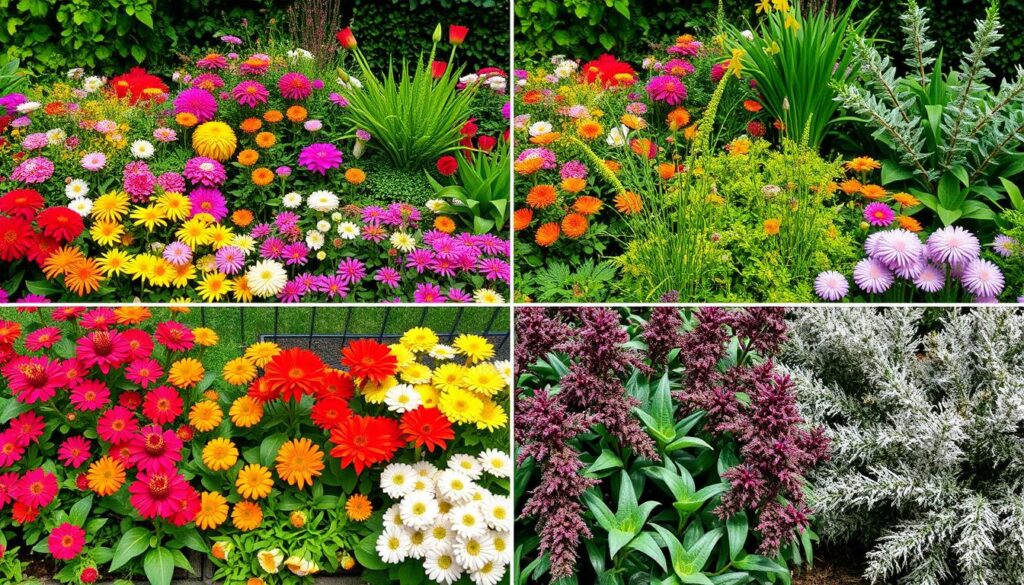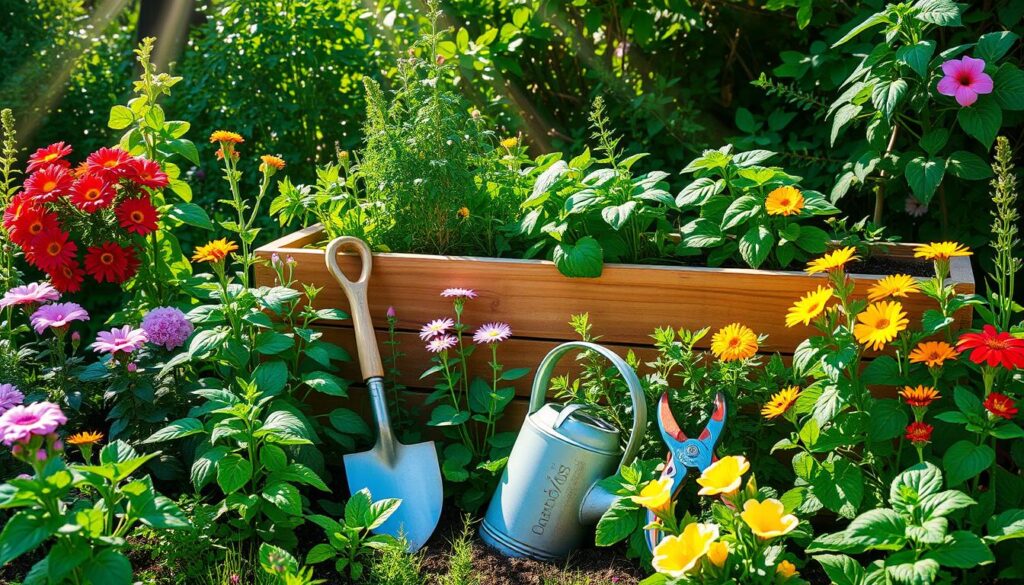Gardening is a rewarding journey that brings self-sufficiency and beauty to your surroundings. It’s important for beginners to learn the basics. This includes mastering plant care and choosing the right plants for different places.
This guide uses insights from “The Garden Primer” by Barbara Damrosch and “Gardening for Dummies.” It aims to give beginners the essential tips they need. It focuses on both the techniques and the joy of growing plants, encouraging people to create lush gardens.
Key Takeaways
- Gardening provides personal satisfaction and health benefits.
- Understanding fundamental gardening concepts is vital.
- Selecting the right plants enhances garden success.
- Essential plant care advice can significantly impact growth.
- Knowledge is key for beginners to avoid common pitfalls.
Understanding the Basics of Gardening
Gardening can be very rewarding. It starts with picking the right spot for your plants. Think about sunlight, shade, and wind patterns. A good spot can make your garden thrive and look beautiful.
Knowing what your plants need is key. Each plant needs different amounts of light, water, and nutrients. Meeting these needs helps them grow well.
Having a plan for your garden is important. It helps you arrange plants in a way that looks good and uses space well. Planting at the right time, with the seasons, helps your plants grow best.
It’s also important to know your local climate. Different places have different challenges and opportunities. Knowing your climate helps you choose the best plants and when to plant them. Your personal taste also plays a big role in choosing plants that you like and that fit your space.

| Aspect | Considerations | Benefits |
|---|---|---|
| Location | Sunlight, shade, wind | Optimal growth conditions |
| Plant Needs | Water, light, nutrients | Healthy, vibrant plants |
| Garden Layout | Arrangement, spacing | Aesthetic appeal |
| Climate | Seasonality, hardiness zones | Informed plant choices |
| Personal Preference | Type of plants, aesthetics | Engaging and enjoyable gardening |
Essential Plant Care Advice
Caring for plants means knowing about watering and soil types. These are key to keeping plants healthy and your garden thriving. Learning about them can improve your gardening skills, whether you’re new or experienced.
Watering Techniques for Healthy Plants
Watering is vital for healthy plants. It’s important to get the timing and method right. Too much water can harm roots, while too little can dehydrate plants. Finding the right balance is crucial.
Using a moisture meter can help figure out when to water. This tool measures soil moisture, guiding you to the perfect watering time.
- Water early in the morning to minimize evaporation.
- Water deeply to encourage strong root development.
- Avoid watering the leaves, as this can promote fungal diseases.
Understanding Soil Types and Their Importance
Knowing about soil types is essential for plant care. Different soils affect how plants get nutrients and drain water. A simple soil test can show the soil’s pH and nutrient levels.
This information helps you make the right changes to improve your soil. It’s a key part of caring for your plants.
The table below outlines various soil types, their characteristics, and their suitability for different plants:
| Soil Type | Characteristics | Best For |
|---|---|---|
| Sandy Soil | Well-draining, low fertility | Cacti, succulents |
| Clay Soil | Heavy, holds moisture | Rice, irises |
| Loamy Soil | Balanced texture, nutrient-rich | Most vegetables, flowers |
| Silty Soil | Smooth texture, good moisture retention | Berries, vegetables |

Choosing the Right Plants for Your Garden
Exploring the world of plants can be fun but also overwhelming for new gardeners. Picking the right plants is key to a healthy garden. Knowing the best plants for beginners and how to choose seasonally is very helpful.
Best Plants for Beginners
Beginners should choose plants that are easy to care for. Here are some good options:
- Succulents: These plants are tough and need little water.
- Marigolds: They are bright, cheerful, and keep pests away.
- Lavender: This herb is not only pretty but also loves dry soil.
- Spider plant: It’s great for cleaning the air and grows well in light.
- Petunias: These flowers are colorful and can handle the heat.
Seasonal Plant Selection Tips
Knowing when to plant makes your garden look better and grow better. Each season is best for different plants. Here are some tips:
- Spring: Plant hardy annuals and perennials for lots of flowers.
- Summer: Use plants that can handle the heat, like zinnias and basil.
- Fall: It’s a good time to plant bulbs and perennials for spring.
- Winter: Get your garden ready for spring by mulching and planning.

Gardening Tools Every Beginner Needs
Starting a garden is an exciting adventure. The right tools are key to success. Beginners should get the essential equipment for easy planting and care. A well-equipped gardener is set for a thriving garden. This section covers the basic tools for beginners and how to care for them.
Basic Tools for Starting Your Garden
Some tools are essential for gardening. Here’s a list of must-haves:
- Trowel – Perfect for digging, planting, and transferring soil.
- Pruners – Essential for trimming plants and maintaining shape.
- Gardening Gloves – Protects hands from thorns and dirt.
- Garden Rake – Ideal for leveling soil and gathering debris.
- Watering Can or Hose – Necessary for providing moisture to plants.
How to Maintain Your Gardening Tools
Keeping tools in good condition is important. A few simple steps can help:
- Cleaning – Remove soil and debris from tools using water and a brush.
- Drying – Ensure tools are completely dry to prevent rusting.
- Sharpening – Regularly sharpen blades of pruners and hoes for efficient cutting.
- Storage – Store tools in a dry, covered area to protect them from the elements.
Investing in the right tools and maintaining them well can greatly improve your gardening. It ensures a thriving garden.
| Tool | Function | Maintenance Tip |
|---|---|---|
| Trowel | Digging and planting | Clean after each use |
| Pruners | Trimming plants | Sharpen blades regularly |
| Gardening Gloves | Hand protection | Wash after heavy use |
| Garden Rake | Leveling soil | Store in a dry place |
| Watering Can | Moisture provision | Drain and dry after use |
How to Grow Thriving Plants Indoors
Growing plants indoors can be both challenging and rewarding. It’s important to get the lighting right and stick to a care routine. This will help your plants thrive and make gardening indoors fun.
Lighting Conditions for Indoor Plants
Choosing the right lighting is key for indoor plants. Not all homes get enough sunlight. Here are some options:
- Natural Light: Put plants near windows for direct or filtered sunlight, depending on their needs.
- Artificial Light: Grow lights are a good choice if natural light is lacking. Full-spectrum lights work well for many plants.
Indoor Plant Care Routine
Having a regular care routine is crucial for indoor plants. It helps them stay healthy and vibrant. Here are the main steps:
- Watering: Check the soil moisture before watering to prevent root rot.
- Fertilizing: Use the right nutrients during the growing season to support growth.
- Humidity Control: Keep the humidity right, especially for tropical plants, with misting or humidifiers.
Common Mistakes in Gardening and How to Avoid Them
Starting out in gardening can be tough. Many beginners make common mistakes. One big error is planting too close together. This makes plants fight for space and nutrients.
It’s important to know how much space each plant needs. This helps them grow well.
Not knowing what plants need is another mistake. Each plant wants different things like sunlight, water, and soil. Learning about these needs can prevent problems.
Choosing the right plants is key to a healthy garden. This way, your garden will thrive.
Watering too much is a big problem. It can cause roots to rot. It’s crucial to water correctly and check the soil often.
Using a moisture meter helps figure out when to water. This keeps plants healthy.
| Gardening Mistake | How to Avoid Gardening Failures |
|---|---|
| Overplanting | Research optimal spacing and choose companion plants wisely. |
| Ignoring Soil Quality | Test soil pH and nutrient levels; amend with compost as necessary. |
| Inconsistent Watering | Establish a regular watering schedule; monitor soil moisture frequently. |
| Not Pruning Properly | Learn proper pruning techniques to promote healthy growth. |
| Planting at the Wrong Time | Refer to planting calendars and local climate conditions. |
By knowing these mistakes and how to avoid them, new gardeners can have a great garden. Paying attention to details and learning is key to success.
Basic Gardening Techniques for Successful Growth
Mastering basic gardening techniques is key to growing healthy plants. Knowing how to plant and prune is crucial. These basics are the foundation for a vibrant garden.
Planting Techniques for Optimal Growth
Effective planting starts with the right seed depth and spacing. Here’s how to plant for the best results:
- Seed Depth: Plant seeds based on their size. Big seeds go deeper, small ones closer to the surface.
- Spacing: Give each seed enough room. This helps with air and nutrient flow.
- Timing: Plant at the best time for your area’s climate. This ensures seeds germinate well.
Understanding Pruning and Its Benefits
Pruning is vital in gardening. It boosts plant health and productivity. The main benefits are:
- Encouraging Growth: Cutting off dead or damaged parts helps new growth and keeps the plant’s shape.
- Improving Airflow: Pruning lets air move better, reducing disease risks from too much moisture.
- Increasing Yield: Pruning can increase flowers or fruits on your plants.
Using these basic gardening techniques daily can bring joy. You’ll see your plants thrive all season long.
Creating the Perfect Garden Environment
Creating a great garden environment is key for plants to thrive. Good garden preparation includes soil quality, sunlight, and wind protection. These elements help make a welcoming space for plants to grow well.
Preparing Your Garden Space
Before planting, it’s important to get your garden ready. This means:
- Testing the soil quality to check nutrients and pH levels.
- Adding organic matter or fertilizers to make the soil better.
- Picking a spot with the right sunlight for your plants.
- Using windbreaks to protect plants from strong winds.
Maintaining Ideal Temperature and Humidity
After preparing your garden, keeping the right temperature and humidity is crucial. Important steps include:
- Using mulch to keep soil temperature steady and moist.
- Watching indoor conditions if you’re growing plants inside, making sure they have enough light and air.
- Changing how often you water based on the weather to keep the soil just right.
| Aspect | Importance | Tips |
|---|---|---|
| Soil Quality | Provides necessary nutrients | Test and amend regularly |
| Sunlight Exposure | Direct sunlight fosters growth | Position plants according to their sunlight needs |
| Wind Protection | Prevents damage to delicate plants | Use barriers like fences or hedges |
| Temperature Regulation | Affects plant metabolic processes | Use mulch and shade as needed |
| Humidity Control | Affects water uptake and resilience | Adjust watering based on climate |
By focusing on these key elements, gardeners can make a garden that supports plant growth. Good preparation is the first step to a successful gardening journey.
Pest Control and Plant Disease Management
Keeping a garden healthy means watching out for pests and diseases. Knowing about common pests and how to control them is key. It makes gardening better. Also, taking care of plant disease management helps your garden grow well.
Identifying Common Pests
Many pests can harm gardens and slow down growth. Spotting them early is crucial. Here are some common ones:
- Aphids
- Spider mites
- Whiteflies
- Fungus gnats
- Leafhoppers
Knowing these pests helps gardeners take action to protect their plants.
Natural Remedies for Pest Control
Using natural pest control methods is popular. They work well and are good for the environment. Here are some good options:
- Neem oil – Keeps pests away by stopping their life cycle.
- Insecticidal soap – Kills soft-bodied pests without harming good bugs.
- Biological pest control – Uses natural enemies to control pests.
These methods help control pests and support a green approach to plant disease management.
The Importance of Composting in Gardening
Composting is a key tool for gardeners wanting to improve soil quality. It involves breaking down organic materials into nutrients for the soil. This process makes the soil richer and helps it hold moisture better, which is good for plants.
Composting does more than just add nutrients. It also makes the soil better for air and water to get through. This is important for plants to grow strong. So, composting is a must for any gardener.
Starting a compost bin at home is easy. You can add kitchen scraps, yard waste, and other organic stuff. Use things like fruit peels, grass clippings, and shredded leaves. But don’t put meat, dairy, or cooked foods in it to avoid bad smells and pests.
Composting also helps the environment by reducing waste in landfills. As gardeners learn about composting, they help the planet and their gardens. It’s a win-win for everyone.
Using Mulch to Maintain Soil Health
Mulching is a key gardening practice that boosts soil health. It helps keep the soil moist, stops weeds, and controls temperature. Knowing the right mulch and how to use it can make your garden flourish.
Types of Mulch and Their Benefits
Each mulch type has its own benefits for soil and plants. Let’s look at some common ones:
| Type of Mulch | Description | Benefits |
|---|---|---|
| Organic Mulch | Comprises natural materials like wood chips, leaves, and straw. | Improves soil health as it decomposes, adds nutrients, and attracts beneficial organisms. |
| Inorganic Mulch | Includes materials like plastic, gravel, or rubber. | Effective in weed suppression and moisture retention, though it does not improve soil health. |
| Stone Mulch | Utilizes stones or pebbles around plants. | Helps in regulating soil temperature while providing a decorative touch. |
| Straw Mulch | Consists of dried straw, often used in vegetable gardens. | Enhances soil health as it breaks down, while effectively controlling weeds. |
How to Apply Mulch Effectively
Choosing the right mulch is just the start. Here’s how to apply it well:
- Ensure the ground is clear of weeds and debris before mulching.
- Spread an even layer of mulch, ideally 2-4 inches thick, around plants.
- Avoid piling mulch too close to plant stems to prevent rot.
- Replenish mulch as needed, especially after heavy rain or over time as it decomposes.
Conclusion
Gardening is a rewarding journey filled with growth and learning. This summary covers key techniques for nurturing plants. By learning about watering, soil, and pest control, anyone can grow a thriving garden.
Patience and persistence are crucial in gardening. Each plant has its own story. Learning to care for them makes the garden and the gardener’s experience richer.
Lastly, gardening is a skill that keeps growing. Exploring new varieties and techniques helps gardeners find what works best. With enthusiasm and curiosity, anyone can start their gardening journey and see their dreams come true.

